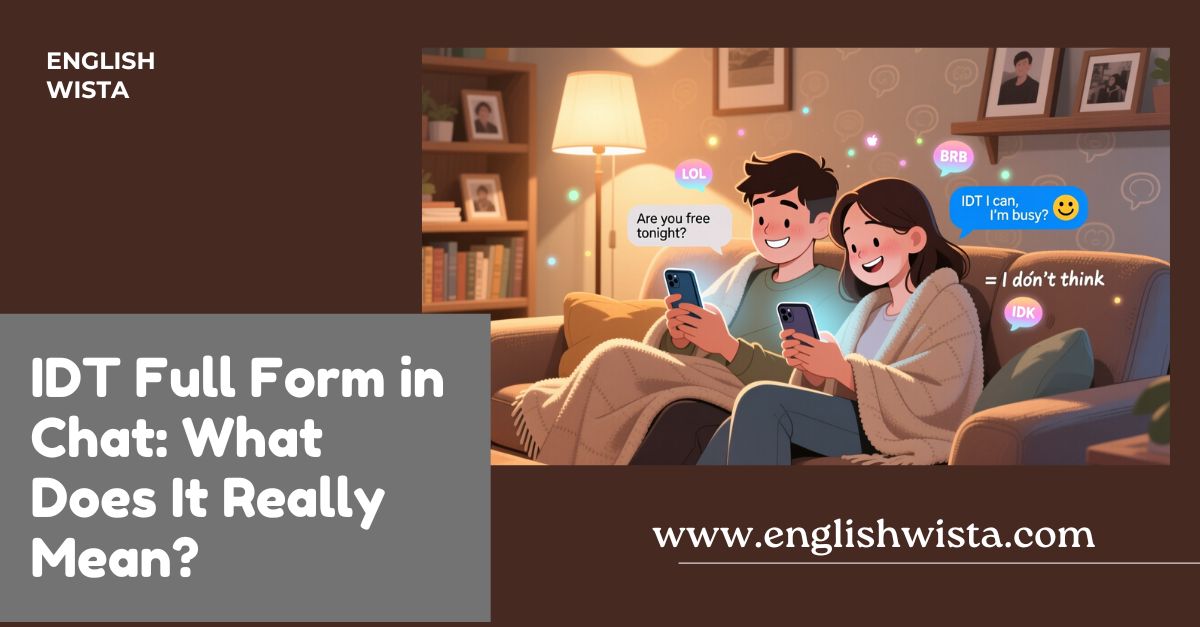Have you ever been chatting online with a friend or scrolling through social media when you came across the abbreviation “IDT”? You stop for a second, scratch your head, and think, “Wait, what does that even mean?” Don’t worry you’re not alone.
The world of online chats and text messages is filled with short forms, acronyms, and slang that can feel confusing, especially if you’re new to them. Some are easy to guess, like LOL (laugh out loud) or BRB (be right back). But others, like IDT, are less obvious.
In this article, we’re going to break down the meaning of IDT in chat. We’ll explore its full form, how it’s used, real-life examples, and even a few fun facts along the way. By the end, you’ll feel confident using it or at least understanding it whenever it pops up in your messages.
Let’s dive in!
What Does IDT Mean in Chat?
The full form of IDT in chat is:
“I Don’t Think.”
It’s a simple abbreviation people use when they want to quickly express doubt or uncertainty in a conversation. Instead of typing the full sentence “I don’t think,” you just write IDT.
Here’s a quick example:
- Friend: “Are you coming to the party tonight?”
- You: “IDT I can make it. I have too much homework.”
See how short and quick that feels? That’s exactly why people use abbreviations like IDT it saves time and effort, especially when chatting on the go.
Why Do People Use IDT Instead of Writing It Out?
Good question! Let’s look at the reasons:
- Speed: In fast-moving conversations, you don’t always have time to type long sentences. IDT helps keep the flow going.
- Convenience: Shorter words = less effort. Perfect for texting on small screens.
- Style: Abbreviations are part of internet culture. Using them makes you sound more casual and in-the-know.
- Character limits: On some platforms (like Twitter/X), shorter text helps you fit more in.
So, IDT is really just about saving time while staying clear.
Common Confusions About IDT
You might wonder, “Wait… could IDT mean something else?” And the answer is yes! Abbreviations can often have multiple meanings depending on the context.
Here are a few other possible meanings of IDT:
- Integrated Device Technology (a tech company)
- I Don’t Talk (less common in casual chat)
- I Don’t Text (rare, but sometimes used)
But in everyday chatting and texting, IDT almost always means “I don’t think.”
To figure out which meaning someone intends, always pay attention to the context of the conversation.
How to Use IDT in Sentences
Let’s make this practical. Here are several examples where you might use IDT in real chats:
- “IDT he’ll be on time, he’s always late.”
- “IDT this plan will work, but we can try.”
- “IDT I can join you today, I’m feeling tired.”
- “IDT she meant to sound rude, maybe it came out wrong.”
- “IDT it’s going to rain, the sky looks clear.”
In each case, IDT works exactly like saying “I don’t think.” It adds your opinion or uncertainty about something.
Is IDT Formal or Informal?
This is an important point. IDT is very informal.
You would not use it in:
- Work emails
- Professional settings
- School essays
- Official documents
But you would use it in:
- Texting with friends
- Group chats
- Casual social media posts
- Informal online discussions
So, think of IDT as slang for casual digital conversations, not something to bring into professional writing.
Variations of IDT
Sometimes people combine IDT with other words or phrases to make it fit better. Here are some common variations:
- IDT so → “I don’t think so.”
Example: “Do you think it will snow today?” → “IDT so.” - IDT I can → “I don’t think I can.”
Example: “Can you stay up late tonight?” → “IDT I can, I’m exhausted.” - IDT that’s true → “I don’t think that’s true.”
Example: “She said the test got canceled.” → “IDT that’s true.”
Adding these little words after IDT makes your sentence more complete, but the meaning stays the same.
Fun Fact: Why So Many Chat Abbreviations Exist
You might be curious why do people invent so many abbreviations for chat in the first place?
Here are a few fun reasons:
- SMS history: Back in the early 2000s, text messages had strict character limits (only 160 characters!). People had to shorten words.
- Typing speed: Before smartphones, people used keypad phones. Typing “I don’t think” took forever, so abbreviations became lifesavers.
- Internet culture: Abbreviations became trendy, part of the “cool” way of chatting online. Even today, they stick around as part of digital language.
So, IDT is part of a long tradition of internet short forms that make conversations faster and more fun.
How Is IDT Different From Other Similar Phrases?
Let’s compare IDT with a few similar chat terms:
- IMO (In My Opinion): Used to share personal views. Example: “IMO the movie was too long.”
- IDC (I Don’t Care): Shows disinterest. Example: “IDC if they don’t like it, I’ll still do it.”
- IDK (I Don’t Know): Shows uncertainty or lack of knowledge. Example: “IDK the answer to that question.”
Notice the difference?
- IDT = expressing doubt or disbelief.
- IDK = admitting you don’t know.
- IMO = giving your opinion.
- IDC = showing you don’t care.
Each has its own flavor, but they all belong to the same “chat abbreviation family.”
When Not to Use IDT
As fun and useful as it is, IDT isn’t always the right choice. Here’s when to avoid it:
- With people who might not understand slang. If you’re texting your teacher, boss, or someone not familiar with internet abbreviations, IDT could confuse them.
- In serious conversations. Imagine someone shares sad news, and you reply with “IDT that’s true.” It might come across as dismissive.
- In professional or formal writing. Abbreviations like IDT are for casual contexts only.
If you’re unsure, it’s always safer to write the full phrase “I don’t think.”
Tips for Using IDT Naturally
If you want to start using IDT in your own chats, here are a few easy tips:
- Start small. Use it with friends who already use abbreviations.
- Pair it with context. Don’t just write “IDT.” Make sure the rest of the sentence makes sense.
- Keep it casual. Use it in fun, everyday conversations, not in serious ones.
- Read the room. If no one else in the chat uses slang, maybe stick to full words.
Over time, it’ll feel natural and easy.
A Few More Example Conversations
To really lock in the meaning, let’s look at longer examples:
Example 1:
- Friend: “Do you think our team will win the game tonight?”
- You: “IDT so, they haven’t been playing well lately.”
In Example 2:
- Friend: “Can you help me move this weekend?”
- You: “IDT I can, I already promised my cousin I’d help her.”
Example 3:
- Friend: “She said the teacher canceled class.”
- You: “Hmm… IDT that’s true. I just got an email reminder.”
See how IDT always adds a little bit of doubt or disbelief? That’s its main job.
Quick Definition Recap
Let’s keep this super simple:
- IDT full form: I Don’t Think
- Meaning: A quick way to show doubt, uncertainty, or disbelief in chat.
- Usage: Casual conversations, text messages, online chats.
- Formality level: Very informal don’t use it in professional settings.
That’s the nutshell version!
Conclusion
So, what have we learned?
IDT stands for “I Don’t Think,” and it’s one of those handy little abbreviations that make online chatting faster and easier. It’s mainly used to express doubt or uncertainty in casual conversations. While it can have other meanings in technical or rare cases, in everyday texting, IDT almost always means “I don’t think.”
The next time someone asks, “Are you free tonight?” and you’re not sure, you can reply with, “IDT I can, I’m busy.” Just remember to keep it casual and use it with people who will understand.
Learning abbreviations like IDT makes you feel more comfortable in digital conversations and helps you connect better with others. So go ahead, try it out you’ll see how natural it feels.
And now, if anyone ever asks you, “What does IDT mean in chat?” you’ll be the expert with the answer.



